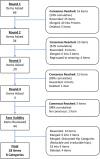Expert-Based Consensus on the Principles of Pavlik Harness Management of Developmental Dysplasia of the Hip
- PMID: 32043064
- PMCID: PMC6959914
- DOI: 10.2106/JBJS.OA.18.00054
Expert-Based Consensus on the Principles of Pavlik Harness Management of Developmental Dysplasia of the Hip
Erratum in
-
Erratum: Expert-Based Consensus on the Principles of Pavlik Harness Management of Developmental Dysplasia of the Hip.JB JS Open Access. 2020 Sep 2;5(3):e18.00054ER. doi: 10.2106/JBJS.OA.ER.18.00054. eCollection 2020 Jul-Sep. JB JS Open Access. 2020. PMID: 33299962 Free PMC article.
Abstract
Developmental dysplasia of the hip (DDH) is the most common orthopaedic disorder in newborns. While the Pavlik harness is one of the most frequently used treatments for DDH, there is immense variability in treatment parameters reported in the literature and in clinical practice, leading to difficulties in standardizing teaching and comparing outcomes. In the absence of definitive quantitative evidence for the optimal Pavlik harness management strategy for DDH, we addressed this problem by obtaining international expert-based consensus on the subject.
Methods: An initial list of items relevant to Pavlik harness treatment was derived by a review of the literature. Delphi methodology was used to guide serial rounds of surveying and obtaining feedback from content matter experts from the International Hip Dysplasia Institute (IHDI), which continued in the same manner until consensus based on standard statistical analysis was reached. This was followed by a corroboration of face validity to derive the final set of management principles.
Results: Four rounds of structured surveying were required to reach consensus. Following 2 rounds of peer review, and from an initial list of 66 items in 8 categories, we were able to derive 2 simplified, yet comprehensive, print-friendly tables consisting of 28 items in 8 categories to assist clinicians in managing DDH with a Pavlik harness. The tables contain principles of treatment initiation, application and follow-up of the harness, complications, weaning, and end-of-treatment decision-making as well as specific criteria based on the severity of the DDH. Furthermore, highly contentious items were identified as important areas of future study.
Conclusions: We developed a comprehensive set of principles based on expert consensus to assist clinicians in the management of DDH using the Pavlik harness. This study also generated a list of the most controversial areas in the nonoperative management of DDH, which should be considered high priority for future study to further refine and optimize outcomes.
Level of evidence: Therapeutic Level V. See Instructions for Authors for a complete description of levels of evidence.
Copyright © 2019 The Authors. Published by The Journal of Bone and Joint Surgery, Incorporated. All rights reserved.
Figures
References
-
- Guille JT, Pizzutillo PD, MacEwen GD. Development dysplasia of the hip from birth to six months. J Am Acad Orthop Surg. 2000. Jul-Aug;8(4):232-42. - PubMed
-
- Benson M, Wainwright A. Developmental dysplasia of the hip. Surgery. 2004;22(1):5-9.
-
- American Academy of Pediatrics. Clinical practice guideline: early detection of developmental dysplasia of the hip. Committee on Quality Improvement, Subcommittee on Developmental Dysplasia of the Hip. Pediatrics. 2000. Apr;105(4 Pt 1):896-905. - PubMed
-
- Holroyd B, Wedge J. Developmental dysplasia of the hip. Mini-symposium: children’s hip problems. Orthop and Trauma. 2009;23:162-8.
-
- Wedge JH, Kelley SP. Strategies to improve outcomes from operative childhood management of DDH. Orthop Clin North Am. 2012. Jul;43(3):291-9. - PubMed
LinkOut - more resources
Full Text Sources
Research Materials

